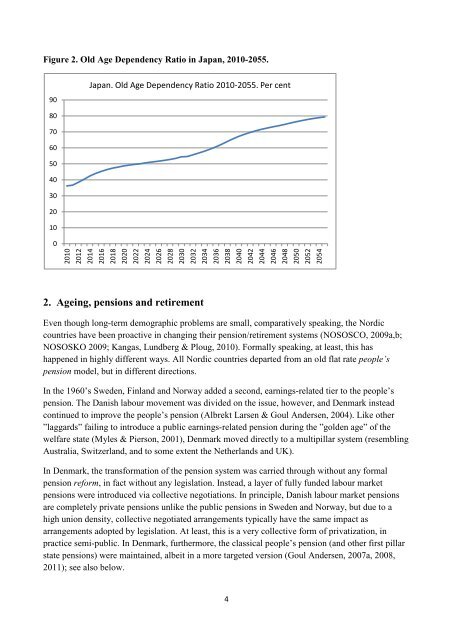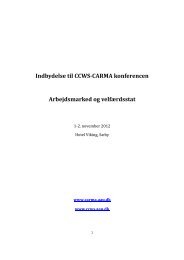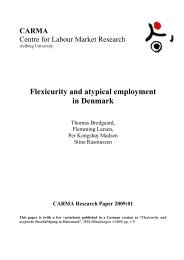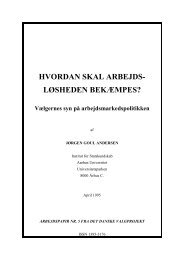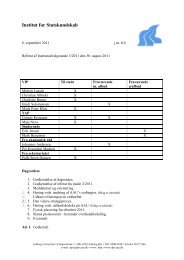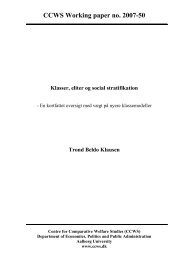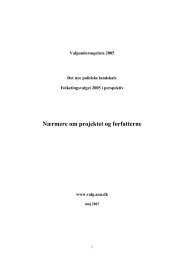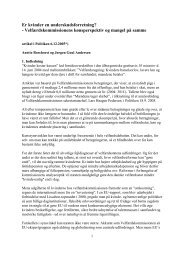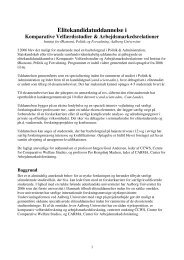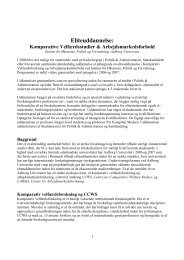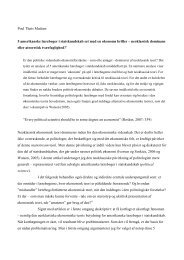Ageing and welfare reform in the Nordic Countries, 1990-2010 ...
Ageing and welfare reform in the Nordic Countries, 1990-2010 ...
Ageing and welfare reform in the Nordic Countries, 1990-2010 ...
Create successful ePaper yourself
Turn your PDF publications into a flip-book with our unique Google optimized e-Paper software.
Figure 2. Old Age Dependency Ratio <strong>in</strong> Japan, <strong>2010</strong>-2055.90Japan. Old Age Dependency Ratio <strong>2010</strong>-2055. Per cent807060504030<strong>2010</strong>0<strong>2010</strong>20122014201620182020202220242026202820302032203420362038204020422044204620482050205220542. <strong>Age<strong>in</strong>g</strong>, pensions <strong>and</strong> retirementEven though long-term demographic problems are small, comparatively speak<strong>in</strong>g, <strong>the</strong> <strong>Nordic</strong>countries have been proactive <strong>in</strong> chang<strong>in</strong>g <strong>the</strong>ir pension/retirement systems (NOSOSCO, 2009a,b;NOSOSKO 2009; Kangas, Lundberg & Ploug, <strong>2010</strong>). Formally speak<strong>in</strong>g, at least, this hashappened <strong>in</strong> highly different ways. All <strong>Nordic</strong> countries departed from an old flat rate people’spension model, but <strong>in</strong> different directions.In <strong>the</strong> 1960’s Sweden, F<strong>in</strong>l<strong>and</strong> <strong>and</strong> Norway added a second, earn<strong>in</strong>gs-related tier to <strong>the</strong> people’spension. The Danish labour movement was divided on <strong>the</strong> issue, however, <strong>and</strong> Denmark <strong>in</strong>steadcont<strong>in</strong>ued to improve <strong>the</strong> people’s pension (Albrekt Larsen & Goul Andersen, 2004). Like o<strong>the</strong>r”laggards” fail<strong>in</strong>g to <strong>in</strong>troduce a public earn<strong>in</strong>gs-related pension dur<strong>in</strong>g <strong>the</strong> ”golden age” of <strong>the</strong><strong>welfare</strong> state (Myles & Pierson, 2001), Denmark moved directly to a multipillar system (resembl<strong>in</strong>gAustralia, Switzerl<strong>and</strong>, <strong>and</strong> to some extent <strong>the</strong> Ne<strong>the</strong>rl<strong>and</strong>s <strong>and</strong> UK).In Denmark, <strong>the</strong> transformation of <strong>the</strong> pension system was carried through without any formalpension <strong>reform</strong>, <strong>in</strong> fact without any legislation. Instead, a layer of fully funded labour marketpensions were <strong>in</strong>troduced via collective negotiations. In pr<strong>in</strong>ciple, Danish labour market pensionsare completely private pensions unlike <strong>the</strong> public pensions <strong>in</strong> Sweden <strong>and</strong> Norway, but due to ahigh union density, collective negotiated arrangements typically have <strong>the</strong> same impact asarrangements adopted by legislation. At least, this is a very collective form of privatization, <strong>in</strong>practice semi-public. In Denmark, fur<strong>the</strong>rmore, <strong>the</strong> classical people’s pension (<strong>and</strong> o<strong>the</strong>r first pillarstate pensions) were ma<strong>in</strong>ta<strong>in</strong>ed, albeit <strong>in</strong> a more targeted version (Goul Andersen, 2007a, 2008,2011); see also below.4


